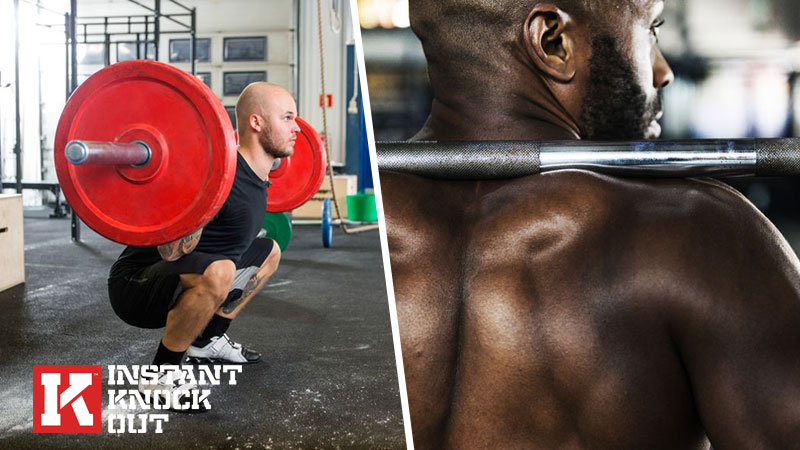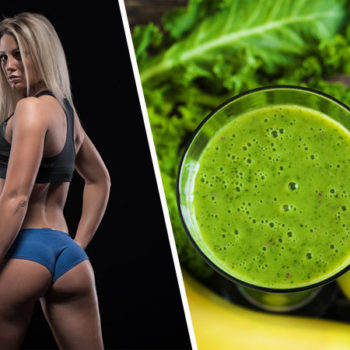High Rep Squats for Fat Loss: Shred Fat Fast With Volume

If the name of the game is to slash your way down to single digit body you need some high rep squats in your life. Not only do they create huge quads and a powerful posterior, high volume squats also ramp up your metabolism and energy expenditure.
When it comes to muscle-building, fat-melting exercises, the squat is King. A tough session of ass-to-grass squats will torch your metabolism and provide a potent stimulus for increasing mass and strength.
Squats get you strong, lean and powerful.
The problem is, when you think of squats you might automatically think that heavy is the only way to go. But there’s a whole new world of high-volume protocols that will obliterate fat and boost athleticism.
If you want to know everything there is to know about high rep squats for fat loss, this is the article for you…
Here’s what you’ll learn
- Why energy expenditure is so important for fat loss
- There are multiple benefits to squatting for body composition
- High rep squats are used by bodybuilders to get shredded and build quad mass
- Using cluster training to burn fat
Fat Loss – Balancing Energy In vs Energy Out
The basis of any good diet, exercise program or lifestyle plan is that it focuses on what’s really important. When it comes to dropping body fat or losing weight, there’s no denying that calories are what makes and breaks body composition.
As a measure of energy, calories are dynamic. The laws of thermodynamics state that energy can’t be created or destroyed – and that’s exactly why calorie consumption predicts whether you lose or gain weight.
Energy balance – the key to fat loss
You get energy from food; specifically carbohydrates, fats and proteins. When you eat these foods, your body digests and absorbs the nutrients it needs, and excretes what’s not needed.
The calories in food are used for energy.
But you only need so many before you take on too more than your body needs.
Maintenance
If energy intake matches the amount you burn off, you reach a state of maintenance and your body mass (weight) remains the same.
Calorie surplus
If you take on too many calories, your body is forced to store them (remember, energy can’t be destroyed, only transferred, so it must somewhere). Through various physiological pathways, this excess energy is converted into triglyceride molecules and stored inside your fat cells.
As far as your body is concerned, it can use it later if needed.
Over time, you’ll store more and more energy in your fat cells and begin to gain both weight and body fat. Before you know it your 20 pounds overweight and wondering what happened.
Calorie deficit
The only ‘trigger’ for fat loss is to force those triglyceride molecules out of their cells and break them down for energy. A calorie deficit is when you take in fewer calories from food than you use each day.
Without a calorie deficit you won’t burn body fat.
If you want to learn more about how to measure your calories and daily your way to a smooth fat shred you can check out our article on “How Many Calories Should You Eat for fat Loss?” with its own built-in calorie calculator.
How Do You Burn Calories?
Understanding the ‘calories in’ part of energy balance is quite simple. Each macronutrient food group provides you with a specific number of calories:
- Carbohydrates – 4 kcal per gram
- Protein – 4 kcal per gram
- Fats – 9 kcal per gram
It’s the ‘calories out’ that’s more complicated.
Because your body uses up stored energy in several ways…
- Basal metabolic rate – these are the calories you burn each day just through basic functions such as brain activity, heart rate, maintenance of muscle mass/body temperature, and kidney/liver function.
- Non-exercise activity – every time you move, fidget, walk, do housework, have sex or take part in any other activity, you burn additional calories above basal levels.
- Digestion and absorption – when you eat food you use the muscles in your gut to break it down. This requires energy.
And last of all…
- Exercise – any type of cardio or strength workout needs an increased number of calories to help you complete it. The harder the workout, the calories energy you burn per minute.
Lift Weights, Lose Fat with High Rep Squats for Fat Loss
In theory you don’t need to exercise to lose fat. All you need to do is take in fewer calories than you burn off.
The problem with this approach though is that without being active you can’t eat that much before you reach maintenance. And with consistently low calories come vitamin deficiencies and various disorders and illnesses.
This is where the ‘train high, eat high’ approach comes in.
If you’ve ever squatted for high reps, you probably remember how it feels. The discomfort, the acid build-up, the fear for your life.
Squats don’t have to be heavy to make gains
The best thing about squats is that they’re one of the most versatile lifts out there. Not only are there endless variations (back, front, overhead, Zercher squat for example), you can also attack it with a variety of rep ranges.
High rep squat are what nightmares are made of.
The lactic acid you build up in your muscles is enough to bring a tear to your eyes. And as paralysis-inducing fatigue begins to set in, that bar will feel excruciatingly heavy. Even if the first few reps were as light as a feather.
High rep squats are as much a test of resolve and willpower as they are for your cardio system and quads. Some of the best bodybuilders ever to have graced the Olympia stage have developed their quads using huge amounts of volume on squat variations.
Key Point: High reps squats for fat loss ramp up energy expenditure – a large component of calorie output.
High rep squats create an anabolic environment for muscle building and fat loss
One of the most important physiological effects of high rep squats is their effects on fat burning, muscle building hormones.
Research shows that when you hack your way through a higher-volume squat workout, you release more growth hormone into your bloodstream. This benefits you in 2 ways.
- Partitioning effect – elevated growth hormone helps to divert calories to muscle rather than fat cells
- Anabolic effect – is a key mediator of muscle mass
A study published in The Journal of Strength & Conditioning Research [1] found that when single versus multiple sets of back squats were compared for total work and power as well as growth hormone release, it was the high rep / volume protocol which resulted in most benefits. Growth hormone was significantly higher in the high rep group.
Additional studies have shown that growth hormone, as well as another anabolic hormone called IGF-1, are key regulators of muscle mass, strength, protein synthesis and fat mass [2].
Many bodybuilders and strength athletes have experienced huge changes in lower body muscle mass when completing cycles of high rep squats for fat loss.
Excess post-exercise oxygen consumption (EPOC) will burn more fat
When it comes to burning fat, it’s all about energy expenditure.
Cardio is great for fat loss as it increases metabolism and heart rate, helping you to max out your calorie output. But it only does it during exercise.
Strength training is superior to aerobic exercise as it continues to burn calories after you’ve finished your workout.
Through a process of excess post-exercise oxygen consumption (EPOC), your body elevates metabolic rate after exercise in order to repair and restore lost energy, as well as removing by-product build up.
Known as the afterburn effect, EPOC is all about oxygen consumption.
When you’re working out you begin to breathe faster and harder (and yes, during high rep squats for fat loss you most certainly will be). As such, the amount of oxygen you consume and energy you burn increases.
Once the workout has finished you’re left with what’s known as an oxygen deficit.
And in order to correct that deficit, your metabolic rate remains elevated in order to restore your body back to normal.
Although your actual EPOC will vary based on things like body mass and intensity of workout, a high rep squats for fat loss program can lead to an increased metabolism for as long as 24 hours [3].
That’s a big fat burning stimulus while sat at home with your feet up.
Key Point: High rep squats for fat loss increases hormones associated with muscle building and improved body composition.
High Rep Squat Program for Fat Loss
This program takes no prisoners.
It’s designed for anyone that has trained for over 2 years and already has a decent squat max. If your technique isn’t right or you’re at less-than-optimal physical conditioning it will eat you alive.
It’s definitely for the more advanced lifter out there.
You’ll be using high-volume cluster training to build respectable mass while completely carving any excess fat from you physique.
Here’s how the high rep squats for fat loss program works…
The guidelines are simple.
You’ll complete this workout twice per week to maximize results. It goes without saying that you’ll need a good couple of days off between sessions so a Monday, Thursday split for example would work well.
Suffering brings fat loss and growth.
And that’s what we’re aiming for here with this 20 rep workout… using you 8-12 rep max!
Wait, what? That’s impossible surely?
No. It’s completely possible – using cluster training…
High-volume squat clusters
Take 2-3 warm up sets to prepare for what’s to come. Make sure they’re nice and light and use them to build focus, technique and solid form.
Load the bar with your 8-12 rep max. Get ready and begin working through your set. Just before the point of failure, take 5-10 second rest. This is important though – don’t rack the bar, keep it on your back.
Breathe naturally and regain your composure. Once you’re ready, try and grind out more reps. Whether you only get 1 rep or 4 doesn’t matter, just complete as many reps as you can while again avoiding failure.
Take another 5-10 seconds mini-break and keep going like this until you get to 20 total reps.
Using mini intra-set breaks during cluster training helps to give you enough energy to complete a supra-maximal number of reps.
Take a 3-5-minute break and return to crank out another set of 20 reps. You’re aiming for 2 x 20 altogether in this workout.
It won’t be pleasant.
You’ll be testing every ounce of willpower you have, as well as your mental toughness and strength. Chances are you’ll swear, chances are you’ll cry.
But one thing’s for sure… you’ll absolutely shred fat and build a pair of quads that would make even the best bodybuilder green with envy.



